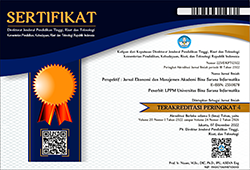Kebijakan Revaluasi Aktiva Tetap dalam Strategi Perpajakan dan Rasio Debt to Equity Ratio ( Studi Kasus PT Pecete)
Abstract
its relevance because it does not reflect the current value so it needs to be read carefully
. Some credit analysts request appraisal assistance to reassess fixed assets if they are
to be used to determine the amount of credit and the feasibility of the entity to receive
credit. But historical values have advantages in terms of reliability. Historical value is
based on the acquisition price at the time of purchase so that the evidence and its value
can be verified. While the fair value or current value for fixed assets is not easily
obtained because there is no active market price for fixed assets. If determined by
the company allows bias in the assessment. Appraisal assessments can provide mixed
results if the assumptions used are different. To avoid the value of assets still losing
relevance, a company can revaluate its fixed assets by following the regulations that
apply according to PSAK, its laws and regulations regarding taxation and regulations
from the decisions of the finance minister. Revaluation is one method of valuing fixed
assets. If an entity chooses to use the revaluation method, this method must be
applied consistently by the company. Companies may not only use the occasional
revaluation method for the purposes mentioned above, but the revaluation must be
carried out regularly.
Full Text:
PDFReferences
Aditya, Gary Y, P. V. U. I. (2018). Revaluasi Aktiva Tetap, Prosedur dan Tax Planning, Januari 20.
Andirei. (2019). Debt to Equity Ratio dalam Laporan Keuangan Perusahaan.
Basar, Y. S. (2016). Revaluasi Aset Untuk Tujuan Perpajakan Ambil atau Jangan. Journal Profita, Volume 9(No.3). Retrieved from http://publikasi.mercubuana.ac.id/index.php/profita/article/view/2877
Dian Maulita, I. T. (2018). Pengaruh Debt To Equity Rasio (DER), Debt To Assets Ratio ( DAR), dan Long Term Debt Ratio ( LDER) terhadap Profitabilitas (Studi Pada Perusahaan Manufaktur Sub Sektor Makanan dan Minuman Yang Terdaftar Di BEI Periode 2011-2016). Journal Akuntansi, Volume 5,(No.2). Retrieved from e-jurnal.lppmunsera.org/index.php/Akuntansi/article/viewFile/669/658%0D
IAI ( Ikatan Akuntan Indonesia). (2012). Standard Akuntansi Keuangan.
J.Weygandt, P.Kimmel, D. K. (2011). Financial Accounting, IFRS Edition. John Willey & Sons Inc.
Mekari. (2019). Tujuan, Keuntungan dan Kelemahan Revaluasi Aset, July.
PECETE. (2015). Laporan Keuangan Tahunan PT. PECETE.
Ramadhan, H. A. (2013). Analisis Revaluasi Aktiva Tetap Terhadap Penghematan Beban Pajak Penghasilan Pada PT Inka Madiun. Journal Akuntansi Akunesa, Volume 1(No.3). Retrieved from https://jurnalmahasiswa.unesa.ac.id/index.php/jurnal-akuntansi/article/view/2287
RI, K. K. (2015). Peraturan Menteri Keuangan, Insentif Pajak , Revaluasi Aktiva Tetap No. 191/PMK.010/2015 dan PER -37/PJ/2015.
Yohanes Handoko. (2010). Nilai Wajar (Fair Value), Strategi, Manajemen, Bisnis, dan Keuangan. Ruang Diskusi. Retrieved from https://rogonyowosukmo.wordpress.com/2010/11/24/nilai-wajar/
DOI: https://doi.org/10.31294/jp.v17i2.6284
Copyright (c) 2019 Jurnal Perspektif
dipublikasikan oleh LPPM Universitas Bina Sarana Informatika Jakarta
Jl. Kramat Raya No.98, Kwitang, Kec. Senen, Kota Jakarta Pusat, DKI Jakarta 10450

This work is licensed under a Creative Commons Attribution-ShareAlike 4.0 International License









